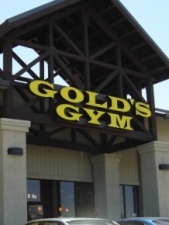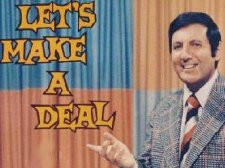 As you already know, the The Art of the Deal was the title of the first of the series of self-promoting books by Donald Trump. In it he talks about his big deals with other major moguls and players on the New York scene.
As you already know, the The Art of the Deal was the title of the first of the series of self-promoting books by Donald Trump. In it he talks about his big deals with other major moguls and players on the New York scene.
But making deals isn’t something reserved just for people in real estate. As a Personal Trainer, it’s something you need to get good at too.
Some people might consider that “work”, but I consider it a perk. You get to deal with people of all levels as part of being a Personal Trainer. This of course makes you a much more competent and confident person. These are qualities you’ll carry for the rest of your professional life. The reality is that as a personal trainer you are a business owner, even though it’s probably only a business of one in the beginning. What’s real funny is that even though you’re “small time”, you still get to join a special fellowship.
Being a business owner of any kind puts you in the same league and brother(or sister)-hood as all other business owners. In some way you are all on the same level, sharing the understanding of the freedom and accompanying uncertainty that comes with controlling your own destiny. So dealing with other business people and forming relationships and partnerships is just a natural part of that.
It also pays big dividends in your personal life. It’s why I find that no matter what situation I go into I always end up making friends with the owner of that business. Whether it’s a gym, restaurant, lounge, or night-club. This has brought me a lot of connections with high-level people in my community, and professional connections that I’m sure will pay dividends as my career grows. When you get proactive about your training practice, you’ll experience the same effect.
Right now we’re going to go into a few of the deals and connections that need to be on the radar of an emerging trainer. If you’re looking to dump the gym, gain experience, and start an independent training practice, these are a few of the connections you need to pursue. All you need is to hit with one deal and your practice is set.
Luxury Condos
 This is the type of training situation I get the most questions about because it’s one that’s worked really well for me (like I talked about in The WhistleblowerReport ). In many cases these buildings have health-clubs, and the interesting fact about that is very few of them actually have on-staff Personal Trainers. Here’s a target group of wealthy clients used to the convenience of on-site service, and there’s noone to fill the need!
This is the type of training situation I get the most questions about because it’s one that’s worked really well for me (like I talked about in The WhistleblowerReport ). In many cases these buildings have health-clubs, and the interesting fact about that is very few of them actually have on-staff Personal Trainers. Here’s a target group of wealthy clients used to the convenience of on-site service, and there’s noone to fill the need!
The reason is that health-club management is a complex job; for that reason most of these buildings don’t go to the trouble of hiring and managing a staff of trainers. That makes them a ripe field for any trainer who can penetrate this market. It’s really an unbelievable situation when you think about it: a built in population of qualified clients, usually no gym fees, and the convenience of being able to see multiple people in one private location. The only problem is …
Getting In
If you do any online or offline marketing, getting into one of these building might just handle itself. In many cases you’ll find that as you launch an aggressive marketing campaign, you’ll get into one of these residences by accident through a new client. The key is that once you’ve penetrated this environment, it’s now your job to grow your influence and contacts in it.
Once you’re in, you can prospect and network through your existing clients, other members you meet, and the gym staff. All you need is a few clients in a location like this; once you’ve got them, you’ll be looked at as a resident specialist. You’ll be able to make an excellent living for as long as you want just from retaining existing clients and converting the trickle of new clients and referrals that come your way into new clients.
Actively Recruiting Locations
If you aren’t introduced into one of these luxury residencies by a client, then you’ll have to actively recruit them yourself. That’s slightly more difficult, but still doable and worthwhile. What you’ll need to do is set-up a meeting between you and the most senior member of the sports and leisure staff.
In this meeting, first tell them about yourself, your experience and qualifications. Get them excited about you and what you have to offer.
But the most important thing to remember in dealing with someone in this situation is what’s in it for them to help you. This type of manager is usually overworked, dealing with member questions and complaints all day. The point you want to emphasize is that you’re here to serve their member’s needs, not make a lot of money yourself. Let them know how you’ll be able to make life much easier for them by helping their residents that don’t know how to exercise to use the gym more effectively. If this gym charges for membership, let them know that you’ll be causing people to utilize the gym more frequently, which will lead to more re-signs. Let them also know they can use you as a selling point to people that are on the fence about joining the gym, worried that they won’t know what to do. Make these the key points of your meeting with the health-club manager and they should understand that this can be a win for both of you.
Bird-Dogs
 When dealing with the employees of the gym like receptionist, you can emphasize a different set of benefits. These people are usually just young people working for minimum wage: all they care about is making money. For them, you can create a system where you give them a kick-back for every new client they bring you. The key here is being subtle – it’s easy to offend someone, no matter how much they make, if you make it sound like you’re bribing them or giving them a hand-out. I have a certain way I like to create these types of “bird-dogs”, as they’re referred to in consulting.
When dealing with the employees of the gym like receptionist, you can emphasize a different set of benefits. These people are usually just young people working for minimum wage: all they care about is making money. For them, you can create a system where you give them a kick-back for every new client they bring you. The key here is being subtle – it’s easy to offend someone, no matter how much they make, if you make it sound like you’re bribing them or giving them a hand-out. I have a certain way I like to create these types of “bird-dogs”, as they’re referred to in consulting.
The first thing I do is attach a page to my website describing my referral policy. I have this page look like an open letter, and in a personal tone I talk in detail about how much I appreciate the effort my affiliates make in referring me to our fellow clients. For this effort, I tell them I can give them a referral fee, and you fill-in whatever amount you want right there; I myself have offered $200 for referrals. If you inform the receptionist about this policy in a friendly and respectful way, they’ll take it seriously and some will actually promote you to gym members aggressively. I’ve had these types of arrangements work for me extremely well, giving me more clients than I could handle. Make sure you can actually convert these prospects into new clients, and make sure you pay your affiliates promptly. The first time they get a big check from you, they’ll be even more thrilled to tell every member about what an excellent trainer you are.
Finding the right residential setting for you to train out of may take some time and research. You’ll first need to locate these buildings, find-out their phone numbers, and do a little detective work on the phone to find out if they allow outside trainers and who’s in charge. But the effort is worthwhile. I’ve seen trainers build an entire practice off of just one of these settings, all in one place with absolutely no overhead or marketing costs. This type of training arrangement has always been a part of my training practice and is one of the keys to the success and ease I’ve had with training.
Teaming With Other Health Professionals
 Speaking of “bird-dogs”, it’s only natural to extend this type of relationship to other people that can bring you qualified leads. This naturally extends to other Health Professionals. They have two things in common with you: they’re around people that actively consume health and fitness services, and just like you, they’re looking to grow their businesses.
Speaking of “bird-dogs”, it’s only natural to extend this type of relationship to other people that can bring you qualified leads. This naturally extends to other Health Professionals. They have two things in common with you: they’re around people that actively consume health and fitness services, and just like you, they’re looking to grow their businesses.
But it’s not all roses – interestingly, for trainers these kinds of deals rarely go anywhere. You’ve probably already tried this yourself and realized that these relationships don’t bring in too many qualified prospects. We need to change that.
The key is to put some stronger bait on the hook – we’re talking about money. Offering them a very strong cash incentive to bring you clients is what you need to do. Follow the same technique I mentioned earlier, with a hidden page on your website that you’ll e-mail as a link to your associates. Again, on this page describe how much you appreciate the confidence these professionals are showing in you by recommending you to their clients, and mention respectfully how you’re willing to reward them for doing so. Most of these professionals won’t have a problem accepting money for something they’d do willingly anyway.
You might find it funny to send back cash in these types of joint ventures; isn’t sending back referrals enough? In the case of Personal Training it’s not, and that’s because of our volume of clients. The nature of our business causes us to have a much smaller client load than say a masseuse or nutritionist. Our clients see us several times a week, so we usually have a much smaller roster of clients. These other professionals clients’ may come to see them once every few months, so they need a high volume of clients to remain viable. If they’re good at what they do, they’ll have many more clients than you and the relationship of trading referrals won’t be in their favor. That’s why these relationships rarely go anywhere for trainers, because the other person knows it’s going to be one-sided. By giving a large cash incentive, we make it worthwhile for the other person to actively refer us to their clients. In the small amount of time it takes to mention you or hand-out your business card to a customer, they can earn a few hundred dollars.
How much should you offer as a finding fee in a joint venture agreement? That depends on how much you charge. In my case, I have a very easy way of figuring this out. I bring new customers into my sales funnel using a three-session introductory package. What I do is make my finding fee the exact price of the intro-pack; depending on what I charge in those first three session, that’s what I’ll give. If you have this arrangement with a few health businesses, you’ll slowly see the leads start to come in.
The only major pitfall with this type of arrangement is that the clients you get might not be the kind you’re looking for. The people that seek out health services usually have health problems or disabilities, which don’t make them ideal Personal Training clients in a lot of cases. I had one deal with a very busy healing arts center go bad because although they sent me a ton of leads, I couldn’t accept a single one!
Business Referral Groups
 As a side note, joining your local chapter of BNI may be a good idea to bring in leads. BNI is a business referral group of professionals in different industries that meets to pass out referrals. They meet every two weeks for one hour, usually at 7am, and pass out referrals among each other. I personally don’t like waking up that early, so my attendance didn’t last long.
As a side note, joining your local chapter of BNI may be a good idea to bring in leads. BNI is a business referral group of professionals in different industries that meets to pass out referrals. They meet every two weeks for one hour, usually at 7am, and pass out referrals among each other. I personally don’t like waking up that early, so my attendance didn’t last long.
There are usually a few chapters open in every area, so before you join find one that is already strong or that’s growing and has motivated members; you can always attend one meeting for free. Once you’re accepted, make sure you’re an active contributor and do your best to bring the other members referrals. It’s a good idea to learn how to contribute value to others; not only your clients but your fellow professionals as well. At the very least let them all know that you’ve linked to them on your website.
The benefit to you is that many of these BNI members are high earning professionals, and they know many more people like themselves. This can quickly turn into a good resource for strong prospects. I myself didn’t hang in long enough to get more clients, but I know other professionals that have done really well here.
Teaming With a Private Gym
 Teaming with a private gym is probably my favorite model; it’s the one where I gained the most experience and learned from the most. I always feel that Personal Training is more than just a profession for us – it’s also a vehicle for us to meet people, to learn about ourselves, and to reach our full potential. In a health club, you’ll get many, many chances to practice your sales skills, have interactions with different types of people, and deal with the social pressure of a public environment. And it’s different when you’re an independent trainer in one of these environments than if you were a gym employee – you have a lot more to own up to.
Teaming with a private gym is probably my favorite model; it’s the one where I gained the most experience and learned from the most. I always feel that Personal Training is more than just a profession for us – it’s also a vehicle for us to meet people, to learn about ourselves, and to reach our full potential. In a health club, you’ll get many, many chances to practice your sales skills, have interactions with different types of people, and deal with the social pressure of a public environment. And it’s different when you’re an independent trainer in one of these environments than if you were a gym employee – you have a lot more to own up to.
Set-Up
What does it mean to have an arrangement with a private gym? It means making an exclusive training deal with a gym that is privately owned. The big chain gyms like Bally’s have their own staff trainers and of course don’t allow outside trainers to work there under any circumstance. However, any gym not corporately owned is up for grabs for a private training agreement. This goes for the big franchises like Gold’s and Powerhouse which are privately owned, large chain gyms with dozens of locations like Dolphin Fitness Clubs, to small private gyms owned by a couple of friends or family members. I’ve personally made successful exclusive training agreements with all three types, and none of them was difficult to negotiate or implement. These also include the franchise health-clubs, private chains, and the mom-and-pop gyms. You can usually negotiate a much better percentage agreement, have much more freedom, and charge whatever you want in these locations. You’ll have freedom over your practice, a captive audience of potential clients, and the benefit of having a solid home-base.
Making these deals is surprisingly easy; that’s because it’s always an interesting group of people that decide to open gyms like this. They’re not always cut out for the nuts and bolts of all the aspects of health club management, especially Personal Training. Training isn’t like any other service, and that’s why no matter how smart or competent these health-club owners may be, they can never really grasp all the nuances of running a training department. Sure, selling memberships and smoothies is easy – you can use the same sales model as any other commodity or food product. But selling a private consulting service like Personal Training is a completely different proposition. What you’ll find is most private health club operators have long since given up on depending on Personal Training as a major revenue earner. They just offer it as an afterthought, either through independent trainers or a gym employee.
This is where a Top-Level Trainer can jump right in. Showing these health club owners what’s possible with their training offerings is a way that you can negotiate a great deal for yourself. Even the independent trainers that these gyms hire are really bad; they’re usually losers that got certified 10 years ago and work about 5 hours a week for the lowest rates in the industry. With the things you learn on this site, you should be able to make a compelling offer to the gym owner and easily blow out any competitor you come across.
 The important thing to negotiate here is the percentage agreement with the health-club owner. You should look for an 80:20 breakdown or a low rent proposition that allows you an even better percentage. You need to keep this arrangement as favorable to you as possible not only for the obvious reason that you want to keep your money, but also because you’ll have some overhead costs in terms of promotional materials and other expenses. For that reason, anything worse than 70:30 is not really worth your time – you’ll find that with your overhead costs, things start to break down. And don’t come in to one of these arrangements in a needy frame or you’ll get taken to the cleaners. Demonstrate that you’re a competent, in demand professional. And remind the facility owner you’re talking to that your overhead costs as a trainer are high. Not only that, but you should also look for perks in this type of exclusive arrangement, like office space to work and conduct client consultations out of, and a lot of freedom when it comes to marketing. This isn’t asking too much when you consider that the gym owner earns a pure 20-25% profit on all the training sold without any of the headaches, and gets the added prestige and new member sign-ups from having a trainer like you training out of their facility. Read the marketing report that’s part of the Whistleblower for ideas on how to market yourself in one of these situations and turn it into a big money earner. Having these marketing materials in hand will also help you create a very strong proposal to the gym owner. And once you’re in one of these gyms, make bird-dogs out of all the staff – get them working for you!
The important thing to negotiate here is the percentage agreement with the health-club owner. You should look for an 80:20 breakdown or a low rent proposition that allows you an even better percentage. You need to keep this arrangement as favorable to you as possible not only for the obvious reason that you want to keep your money, but also because you’ll have some overhead costs in terms of promotional materials and other expenses. For that reason, anything worse than 70:30 is not really worth your time – you’ll find that with your overhead costs, things start to break down. And don’t come in to one of these arrangements in a needy frame or you’ll get taken to the cleaners. Demonstrate that you’re a competent, in demand professional. And remind the facility owner you’re talking to that your overhead costs as a trainer are high. Not only that, but you should also look for perks in this type of exclusive arrangement, like office space to work and conduct client consultations out of, and a lot of freedom when it comes to marketing. This isn’t asking too much when you consider that the gym owner earns a pure 20-25% profit on all the training sold without any of the headaches, and gets the added prestige and new member sign-ups from having a trainer like you training out of their facility. Read the marketing report that’s part of the Whistleblower for ideas on how to market yourself in one of these situations and turn it into a big money earner. Having these marketing materials in hand will also help you create a very strong proposal to the gym owner. And once you’re in one of these gyms, make bird-dogs out of all the staff – get them working for you!
One thing to look out for is standing your ground and always enforcing your independence in any training situation or partnership you enter. If the gym owner starts to think of you as an employee, you’re finished.
Keep In Touch
Once these relationships with gym employees and other professionals are formed, that’s not the end of the story; you have to nurture them, or they’ll never bring you any fruit. You need to stay in constant contact with every new affiliate you bring on your team.
- Send them emails keeping them up to date on what’s happening in your business
- Subscribe them to your blog
- Send them holiday greeting cards
- Invite them to big parties that you, your friends, or other clients might be throwing.
- Buy lunch for the staff on major holidays
- Learn to treat people good
You want them to keep you in the back of their mind, so that when the right time comes, they’ll say “Hey, I know a Personal Trainer that can help you!”. Most people that you take care of will be able to bring you at least 1 to 2 qualified, high-level clients a year. Doesn’t sound like much but remember this: a high-level client is worth at least $10,000 a year to you. But these types of relationships take only about 3-4 hours to create and maintain a year: that’s a tremendous return on investment of your time. If you get really good at it, you’ll eventually have so many prospects, many of which will be potential high value clients, that you won’t be able to serve them all. You can then further raise your rates, hire an assistant to help you serve your clients, or even explore the possibility of opening your own training studio (less expensive than you think).
Old World
 With your marketing, relationship building, and even your training techniques, you’ll find training is very much a return to the “old world”. It’s based on integrity, treating people well, and what you can do for them. There’s a tremendous interpersonal element to it. This career isn’t as simple as applying for a job and letting an employer tell you what to do. You’ve got to be self-directed and a little ambitious. Trainers make $100 an hour, give or take, correct? Your goals should be to get to clients that can pay you that, or create this income in a situation where you keep all or nearly all of the money, and also have the leverage of time and work situation that keeps the job fresh and enjoyable for you.
With your marketing, relationship building, and even your training techniques, you’ll find training is very much a return to the “old world”. It’s based on integrity, treating people well, and what you can do for them. There’s a tremendous interpersonal element to it. This career isn’t as simple as applying for a job and letting an employer tell you what to do. You’ve got to be self-directed and a little ambitious. Trainers make $100 an hour, give or take, correct? Your goals should be to get to clients that can pay you that, or create this income in a situation where you keep all or nearly all of the money, and also have the leverage of time and work situation that keeps the job fresh and enjoyable for you.
Remember, just a single one of these deals can bring you a steady stream of clients, create a successful training practice, and launch your training career. But you may need to use a few of them until you get a client roster you’re happy with.
So get used to it – this is one of the big things training did for me. It got me in front of other important, powerful, and successful people and taught me how to talk and negotiate with them. You just have to keep working and tweaking things until you get the breakthrough level that every experienced trainer can tell you about – that’s when you go from striving for the best clients and your desired income level, to where you don’t want or can’t handle any more. Good luck!
____________________________________________________________________
If you liked this post, wait ’til you read what’s NOT being said on the web:
The UNDERGROUND NEWSLETTER
Sign-up below (your email address WILL NOT be shared):

Dude – this stuff could be a whole separate report.
This just got me thinking a WHOLE LOT DIFFERENTLY about the mindset an independent trainer should have.
I’ve been kind of limiting myself in my thinking and this post may have opened a new world for me..
It seems like your approach to finding the ideal location is to keep trying any or all of these above methods consistently until one day you find your break and it snowballs.
I’d love to see more posts like this one, Kaiser.
Hello Kaiser,
Again you hit another one out of the ball park! So informative and valuable, that you really should be charging at least something for this hardcore information. Some stuff I knew, but most of the stuff you put out, really got my whiskers standing up thinking of new marketing ideas. Thanks!
Like BIG (and I mean like a white BIGGIE) Chris McCombs from Orange County with his Market Annihilator (which I suspect is a bait and switch for the unsuspecting PT) You need to create the “Kaiser Chronicles – Guide to Network Marketing. PDF download with video $14.99. You may never have to work again.
You are getting too good with these posts Kaiser! Haha. Actually in regards to finding a gym in a luxury condo: I happen to train a client that lives in an insane building in downtown Manhattan that has a 20,000++ square foot gym. First day that I started to train them I thought of getting into the gym but ONLY building tenants can enter with a key card and id. Not even guests are allowed!! Even worse I spotted some of the “trainers” outside smoking cigarettes and looking like SH*t!
I WILL find a way to get in there. Kaiser definitely shows that it pays to think outside the box, especially with p.t. as its such a special type of profession.
Great post! A lot of good info and some ideas that I had never thought about or tried before. This post couldn’t come at a better time-with the economy being what it is, it’s really helpful to get a fresh perspective on ways to go about building your business. I may just have to shake up the way I’ve been doing things!
Awesome blog Kaiser, I was one of the guys who emailed you about the condo idea. Been waiting for this one. Kaiser often talks about coming from sleeping in his parents basement, well I feel you bro. I am just coming up from practically the same situation, just got my first client about a week ago and I am more determined than ever. Condos are the next step for me, Im going to take action next week by visiting a few. Thanks again for the article, keep it up!
BTW all the Gold’s I have seen have their own staff of trainers, but that part of the article made me think that some of the “name” gyms might be worth looking into. I kind of considered those all off limits. Makes me think a little broader.
Some great comments on here – I didn’t know this post would be such a hit, especially with the really experienced guys – but we all love to hear new ideas and this ambitious mindset reinforced –
Yeah Doug, this is the kind of mindset you need to have as a trainer – it’s proactivity combined with patience – think of yourself like an independent professional entity, looking to partner and offer your value to the highest bidder while still keeping in mind the growth and success of this entity –
Haha – Rivak you crack me up dude – you’re right! No more free info on the blog – that’s it!
Hey Gaby – yeah reminds me of a situation I was in when I was training in the city – these can turn out really good for you so keep your eye out for them – especially with what I was talking about, making deals with staff members of the gyms and buildings – it’s a lot of work, but with high potential reward –
Thanks Doug – glad you got something out of it –
Yeah Jay this post was for you buddy! – Keep your eye out for these locations – hopefully this post got everyone’s RAS (reticular activating system) awake and on the look-out for big-time connections – and about the private gyms like Gold’s and such, don’t assume – keep your eyes open, and you might find one that hires independent trainers – then talk to the owner and establish yourself as the go-to independent in that location –
I’ll keep coming with more of the real world info for you – and keep reading the newsletters!
Excellent blog Kaiser. These are ‘great action’ strategies on building your PT business. Getting in with a luxury condo would be an ideal situation for a trainer-I need to actively look into this scenerio.
Also-I love the thinking outside of the box idea of offering cash incentive for referrals. Genius. Money gets people moving and is great promotion for a business. I will try this.
This one was gold Kaiser – I like this “how to” information and I agree with Rivak – you need to be charging for this!
And I’m starting to see how this works – I’ll have some questions, trust me! Thanks for the info!
good info, birddogs” for me have always included… hairstylists, they make great clients who with a discount are great referral specialists.
massage therapist, ditto or even trading services.
counslers, they see people who need are help.
Yeah – receptionists have always worked for me really well – I’m completely amazed at how motivated they get to promote you once there’s money in it for them – almost too motivated –
But the best motivator is treating people good and letting them know you care about them as a person – looking out for things you can do for them and keeping them in the loop –
Kaiser, so far I’ve read 3 articles/posts from you and all of them are very valuable. Obviously you put a lot of thought, research and effort.
Thanks!
I will be meeting with the property management team of a newly built condo, in regard to discussing how to go about offering my PT services. There is no fitness center management. If a deal is made I will be the only trainer. Any advice for me.
Hey Yavor – thanks man – when you got the time go ahead and read a few more!
Hey Daphne – golden situation – there are so many of these and they’re a totally untapped market – these people will pay more for on site services, and your expenses are less!!! Yeah, very good to get the blessing of the property management team and letting them get comfortable with you and learning about what you have to offer – this will prevent and problems later on down the line – do they want a cut? Is that what you mean by a deal? If they allow you to market inside the healthclub and your cut is very strong, then I’d say no problem.
Excellent information, thanks for sharing.
Hi Kaiser,
By deal, I was referring to an agreement on the terms in which I will operate in the condo fitness center.
Hey Kaiser this blog is excellent!!!!!! I want to thank you. My career as taken a drastic turn since I have been reading your blog. You totally helped me to simplify my personal training career and earn the most without all the extra hassles.
Keep up the good work.
Daphne
Hey Kaiser,
Cool article.
This gave me a lot to think about as far as my referral marketing.
You brought up a good point that I have always struggled with…
Cross referrals with other wellness pros.
I have a few clients and they have many.
As you said, it is very one sided.
The referral offer is awesome, especially for business owners who cater to my target market.
As far as doctors are concerned, there have been times that I offered doctors a referral fee and they replied that they are not legally allowed to accept a referral fee.
Have you ever come across this situation?
Thanks for an awesome article. :)
Hey Daphne – glad you’re finding the blog so useful!
Hey Alex – yeah, doctors and a lot of nutritionists won’t take money – that’s okay, I know of several trainers that do really well with referrals from this group – you just have to do it through old fashioned credibility – I however have never approached doctors for cross referrals – like I mentioned, I train the generally fit population, and doctors usually deal with illness – physical therapists of course do really well with them.
But yeah, with everyone else, this is the reason why the cross referral program failed – we aren’t around as many clients – but clients are worth a lot more money to us, so you’ve got to put some good bait out there –